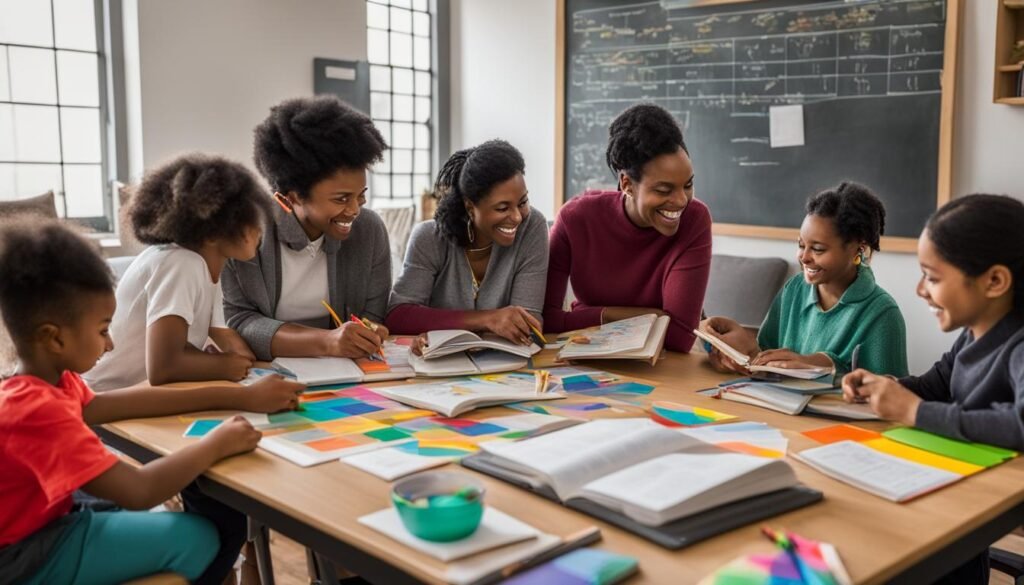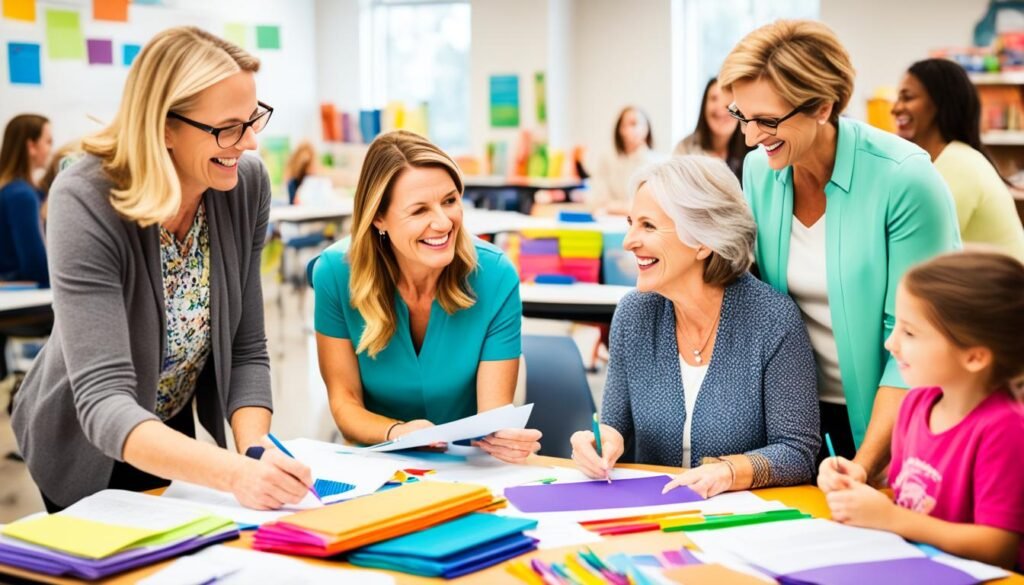Welcome to our blog, where we explore the power of collaboration between parents and teachers in the education journey of our students. At its heart, education partnership between parents and teachers is vital to creating a cohesive and supportive environment for our children’s success. By working together, we can ensure that every student thrives and reaches their full potential.
In this article, we will delve into the various aspects of parent-teacher collaboration and how it impacts education. From understanding special educational needs to navigating curriculum and student diversity, we will explore the strategies and practices that can strengthen the partnership between parents and teachers.
By embracing the Framework for Teaching and creating collaborative learning environments, we can provide holistic development opportunities for our students. We will also discuss the role of communication and family involvement in fostering academic success.
Throughout the article, we will provide practical tips and strategies that parents and teachers can implement to enhance collaboration and amplify student success. Let’s unite as a team and embark on this cohesive education journey together.
Key Takeaways:
- Collaboration between parents and teachers is essential for a cohesive education journey.
- Understanding special educational needs together enhances inclusive education.
- The Framework for Teaching enhances teaching practices in classrooms.
- Effective planning and preparation address curriculum challenges and student diversity.
- Family involvement fosters academic success and student well-being.
The Vital Role of Parent-Teacher Collaboration in Inclusive Education
Inclusive education extends beyond the classroom and involves a collaborative effort between parents and teachers. When parents and teachers join forces, the journey towards a cohesive education becomes more attainable, ensuring the success of every student, especially those with special educational needs.
Understanding Special Educational Needs Together
Parents play a crucial role in supporting the education of children with special needs. By working hand in hand with teachers, they gain a deeper understanding of their child’s unique requirements and challenges. Parents can provide valuable insights into their child’s strengths, weaknesses, and learning styles. This collaborative understanding enables teachers to tailor their instruction and provide targeted support, creating an inclusive environment where every student can thrive.
Facilitating Communication and Shared Goals
Effective communication is the key to a successful parent-teacher collaboration. Open and transparent communication channels allow for the exchange of important information, such as progress updates, concerns, and strategies for supporting the child’s learning journey. By establishing shared goals, parents and teachers can work together to create an individualized education plan that addresses the specific needs of the student. Clear goals ensure that everyone involved is aligned, fostering a cohesive and supportive educational environment.
Collaboration between parents and teachers is not limited to addressing challenges. It also provides an opportunity to celebrate the achievements and progress of students. By sharing successes, parents and teachers can motivate and empower students, boosting their confidence and encouraging them to reach their full potential.
Table: Benefits of Parent-Teacher Collaboration in Inclusive Education
| Benefits | Explanation |
|---|---|
| Personalized support | Collaboration allows for tailored instruction, based on the individual needs of students with special educational needs. |
| Enhanced communication | Open and transparent communication channels foster effective information sharing between parents and teachers. |
| Shared goals | Alignment on shared goals ensures a cohesive approach to meeting the educational needs of the student. |
| Improved student outcomes | Collaboration between parents and teachers has been shown to lead to improved academic and social-emotional outcomes for students. |
| Empowered parents | Collaboration empowers parents to actively participate in their child’s education and advocate for their needs. |
Note: The benefits of parent-teacher collaboration are not limited to those listed in the table above, and may vary depending on individual circumstances and contexts.
Embracing the Framework for Teaching in Our Classrooms
At our institution, we believe in the power of the Framework for Teaching to shape and enhance educational practices in our classrooms. The Framework for Teaching provides a comprehensive and research-based approach to effective teaching, encompassing various domains such as planning and preparation, classroom environment, instruction, and professional responsibilities.
By embracing the Framework for Teaching, we strive to create a cohesive and student-centered learning environment. This framework allows us to set clear goals, plan engaging lessons, and assess student progress effectively. It enables us to develop a common language and understanding amongst teachers and parents, fostering collaboration and shared goals.

The Framework for Teaching provides a roadmap that guides us in delivering high-quality instruction and promoting student achievement, but it is only through the joint effort of teachers and parents that we can truly implement its principles and realize its full benefits.
By embracing the Framework for Teaching together, teachers and parents can align their strategies and support systems to create a holistic learning experience for our students. Teachers can share their expertise and insights with parents, who in turn can provide valuable input and support from home. This collaboration enhances the learning journey of our students and ensures that they receive consistent guidance and reinforcement.
Through embracing the Framework for Teaching, we acknowledge the importance of partnership and appreciate the unique contributions of both teachers and parents. Together, we create a strong educational foundation that empowers our students to thrive academically and personally.
Navigating Curriculum and Student Diversity through Planning and Preparation
In today’s diverse educational landscape, teachers face the challenge of effectively navigating curriculum and meeting the individual needs of students. This requires careful planning and preparation to ensure academic excellence for every student, regardless of their background or abilities.
Adapting Teaching Strategies to Individual Student Needs
One key aspect of navigating curriculum and student diversity is the ability to adapt teaching strategies to meet the unique needs of each student. By recognizing the individual strengths, weaknesses, and learning styles of students, teachers can tailor their instructional methods to maximize student engagement and achievement.
Adapting teaching strategies includes providing differentiated instruction, offering various modalities of learning, and incorporating resources and materials that cater to diverse learning preferences. This fosters an inclusive learning environment where every student feels valued and supported in their educational journey.
Moreover, teachers can utilize formative assessments to gather data on student progress and adjust their teaching methods accordingly. This responsive approach allows teachers to address any learning gaps and provide necessary support to ensure that all students have equitable access to educational opportunities.
Culturally Responsive Planning for Academic Excellence
To navigate curriculum and student diversity effectively, it is crucial for teachers to embrace culturally responsive planning. This approach recognizes and celebrates the cultural backgrounds, experiences, and perspectives of students, and integrates them into the learning process.
Culturally responsive planning involves incorporating diverse texts, materials, and examples that reflect the experiences of the students in the classroom. It also encourages students to share their cultural knowledge and perspectives, creating a rich and inclusive learning environment. By doing so, educators can foster a sense of belonging and empower students to take ownership of their learning.
Culturally responsive planning also strengthens the connection between students’ prior knowledge and the curriculum, making the content more meaningful and relevant to their lives. This approach not only enhances engagement but also supports deeper understanding and retention of knowledge.
| Benefits of Culturally Responsive Planning | Strategies for Implementation |
|---|---|
|
|
Fostering Academic Success Through Family Involvement
At the heart of academic success lies the crucial role of family involvement. When parents actively engage in their children’s education, it establishes a strong foundation for learning and nurtures a supportive environment for growth and achievement. Family involvement goes beyond parent-teacher conferences and school events – it encompasses a holistic approach to education that extends into the home.
Studies consistently demonstrate the positive impact of family involvement on student performance. Research shows that students with involved parents are more likely to earn higher grades, have better attendance rates, and develop stronger self-confidence and motivation. The support, encouragement, and guidance provided by parents play a vital role in shaping their children’s academic journey.
“The active participation of parents in children’s learning process is essential for their overall development. By working together, parents and educators can create an environment that fosters academic success and empowers students to reach their full potential.”
So, how can families get involved in their children’s education and support their academic growth? Here are some effective strategies:
- Establish open lines of communication with teachers to stay informed about your child’s progress, challenges, and achievements.
- Set aside dedicated time for homework and study, providing a quiet and organized space for learning.
- Encourage reading at home by creating a family reading routine and exploring age-appropriate literature together.
- Engage in meaningful discussions about school topics, encouraging critical thinking and intellectual curiosity.
- Attend school events, parent education workshops, and volunteer opportunities to actively participate in the school community.
- Support your child’s interests and hobbies, recognizing the educational value of extracurricular activities.
- Collaborate with teachers in goal-setting and creating an individualized learning plan that aligns with your child’s strengths and needs.
By fostering family involvement in education, we empower our children to become lifelong learners and equip them with the tools for future success. Together, as parents, teachers, and students, we can create a collaborative and supportive environment that paves the way for academic excellence.

Building Strong Relationships for a Thriving School Community
In order to cultivate a thriving school community, it is crucial to foster strong relationships between parents, teachers, and the entire school community. These relationships serve as the foundation for creating a positive and supportive educational environment that nurtures student success.
Building strong relationships starts with open and effective communication. Parents and teachers should engage in regular dialogue, sharing valuable insights and information about each student’s progress, needs, and goals. This collaborative approach helps create a sense of shared responsibility and ensures that everyone is working towards the same objectives.
Another essential aspect of building strong relationships is mutual respect and understanding. Parents and teachers need to recognize and appreciate each other’s unique perspectives and contributions. This can be achieved through creating opportunities for parents to get involved in the school community, such as attending parent-teacher association meetings, volunteering, or participating in school events.
Moreover, creating a sense of belonging and inclusivity within the school community is key to establishing strong relationships. Schools can organize activities that bring parents, teachers, and students together, fostering a sense of unity and shared purpose. This can include events like family picnics, cultural celebrations, or workshops on parenting and education topics.
“When parents and teachers form strong relationships, it creates an environment where students feel supported and motivated to excel academically and personally.”
Ultimately, building strong relationships within the school community sets the stage for collaboration and cooperation, leading to improved student outcomes and a thriving educational environment. Parents, teachers, and the school community must work together, embracing their collective roles and responsibilities, to ensure the success and well-being of every student.
Parenting and Education Partnerships
In order to promote student success, it is crucial to establish strong partnerships between parents and educators. By working together, parents and educators can create a supportive and enriching learning environment for children. Integrating parents in daily educational activities and supporting educators to foster parent engagement play key roles in nurturing these partnerships.
Integrating Parents in Daily Educational Activities
Incorporating parents in daily educational activities helps bridge the gap between home and school, allowing for a more holistic approach to a child’s education. Parents can contribute their unique insights and experiences to enhance classroom learning. They can assist in organizing and participating in field trips, workshops, or cultural events that enrich the educational experience. By actively involving parents in the learning process, children gain a deeper understanding of the relevance and application of their education.
Supporting Educators to Foster Parent Engagement
Educators play a fundamental role in facilitating parent engagement and building effective partnerships. By providing resources, guidance, and regular communication, educators can empower parents to actively participate in their child’s education. This can be achieved through regular parent-teacher conferences, school newsletters, and online platforms that facilitate easy and efficient communication. Encouraging parental involvement not only benefits the child but also strengthens the overall school community.
By fostering strong parenting and education partnerships, we can create an educational environment that is inclusive, collaborative, and supportive of each child’s unique needs. These partnerships enable parents and educators to effectively work together, ensuring that children receive the best possible education and support for their academic growth and personal development.
Creating Collaborative Learning Environments
In order to foster holistic student development, it is crucial to create collaborative learning environments where parents and teachers work together. Collaborative learning environments encourage open communication, shared responsibilities, and the alignment of home and school values, all of which contribute to learner growth.
Sharing Responsibilities for Holistic Student Development
In collaborative learning environments, both parents and teachers share the responsibility for the holistic development of students. This involves recognizing and respecting each other’s expertise and strengths, and actively collaborating to provide a well-rounded education. Parents can support classroom learning by reinforcing concepts at home, engaging in regular communication with teachers, and participating in school activities. Teachers, on the other hand, can involve parents in decision-making processes, provide regular updates on student progress, and seek input from parents to better understand each student’s unique needs. By sharing responsibilities, parents and teachers can create a supportive and enriching educational experience for students.
Aligning Home and School Values for Learner Growth
When home and school values are aligned, learners benefit from a consistent and cohesive approach to education. Collaboration between parents and teachers allows for the sharing of values, beliefs, and expectations, which helps create a positive and nurturing environment for students. By aligning their approaches, parents and teachers can reinforce the importance of core values such as respect, responsibility, and empathy. This alignment also enables parents and teachers to support each other in reinforcing positive behaviors and addressing any challenges that may arise. When home and school values are in harmony, learners experience a seamless transition between their home and school lives, ultimately leading to enhanced learner growth.

Communicating Effectively for Enhanced Learning Outcomes
“Effective communication is the key to unlocking enhanced learning outcomes for our students. By fostering open and transparent channels of communication between parents and teachers, we can create a collaborative environment that supports student success.”
When parents and teachers communicate effectively, they have a shared understanding of a student’s progress, strengths, and areas for improvement. This allows for tailored support and targeted interventions, leading to enhanced learning outcomes. Here are some strategies to improve communication:
- Regular Updates: Teachers can provide timely updates on student progress, achievements, and challenges. This can be done through newsletters, online platforms, or scheduled parent-teacher conferences.
- Active Listening: Both parents and teachers should actively listen to each other’s concerns, perspectives, and feedback. This fosters mutual understanding and promotes collaboration.
- Two-Way Feedback: Encouraging a feedback loop where parents and teachers share insights and observations helps in identifying student needs and determining appropriate interventions.
- Transparency: Open and transparent communication ensures that both parents and teachers are well-informed about important school policies, curriculum changes, and upcoming events.
- Digital Tools: Utilizing technology, such as email, online platforms, and messaging apps, can facilitate timely and convenient communication between parents and teachers.
“Remember, effective communication is a two-way street. By actively engaging in open and transparent conversations, we can create a supportive network that fosters enhanced learning outcomes for all our students.”

Promoting Positive Parenting Practices in Education
Positive parenting practices play a crucial role in supporting a child’s educational journey. By providing educational support and advocating for their child at home, parents can enhance their child’s learning experience and academic success.
Encouraging Educational Support and Advocacy at Home
One of the key ways parents can promote positive parenting practices in education is by offering consistent educational support at home. This can involve creating a conducive learning environment, establishing a routine for study time, and providing resources and materials that complement classroom learning.
Furthermore, parents can engage in advocacy at home by being actively involved in their child’s education. This includes staying informed about their child’s progress, attending parent-teacher conferences, and communicating regularly with teachers to understand their child’s strengths, challenges, and areas for improvement.
By offering educational support and advocating for their child’s needs, parents can contribute to a collaborative partnership between home and school, ensuring that their child receives the necessary resources and support to thrive academically.
Learning At Home: Extending Education Beyond School Walls
Learning at home is an excellent way to extend education beyond the walls of the classroom. It presents opportunities for parents to engage in additional educational activities with their child, fostering a love for learning and curiosity beyond the formal school setting.
Parents can incorporate educational activities into daily routines, such as reading together, discussing current events, or exploring educational websites and apps. By making learning a fun and interactive experience, parents can create a positive association with education and encourage lifelong learning habits in their child.
Additionally, learning at home allows parents to personalize their child’s education, tailoring activities and resources to their child’s unique interests and learning style. This individualized approach can boost engagement, motivation, and overall educational outcomes.
Parents can also leverage technology to explore virtual field trips, online educational platforms, and educational videos that align with their child’s curriculum. These resources can provide a rich and diverse learning experience, expanding their child’s knowledge and understanding of various subjects.
Overall, by promoting educational support and advocacy at home and encouraging learning beyond the school walls, parents can play an active role in their child’s education and contribute to a well-rounded, holistic learning experience.
Strengthening the School and Home Collaboration
In order to create a cohesive education journey, it is crucial to strengthen the collaboration between schools and homes. By working together, parents and teachers can provide the necessary support and resources to help students succeed academically and personally. Here are some practical strategies for fostering partnerships and enhancing the school and home collaboration:
- Regular Communication: Establish open and transparent lines of communication between parents and teachers. This can include regular updates on student progress, sharing of important information, and maintaining an ongoing dialogue to address any concerns or questions.
- Parent Involvement: Encourage and welcome parent involvement in school activities and events. By inviting parents to participate in classroom activities, school committees, or parent-teacher associations, schools can create a sense of belonging and strengthen the partnership between parents and teachers.
- Home-School Connections: Promote activities that connect the classroom learning to the home environment. This can include providing resources for parents to support their child’s learning at home, sharing ideas for educational activities, and involving parents in the reinforcement of key concepts taught in school.
- Collaborative Goal-Setting: Involve parents in setting academic and personal goals for their child. By working together to establish shared goals, parents and teachers can align their efforts and provide consistent support to help students achieve these objectives.
- Professional Development for Parents: Offer workshops or training sessions for parents to develop skills and knowledge that can support their child’s education. Topics such as effective communication, understanding curriculum standards, and navigating educational resources can empower parents to play an active role in their child’s learning journey.
By implementing these strategies, schools can strengthen the collaboration between parents and teachers, creating a supportive and engaging educational environment for students. When schools and homes work together, students thrive academically and socially, setting a solid foundation for their future success.
Amplify Student Success through Parent Engagement
Parent engagement is a crucial factor in amplifying student success. When parents actively participate in their child’s educational journey, they provide invaluable support and advocacy that can make a significant difference in their child’s learning experience. By working together, parents and teachers create a powerful partnership that promotes positive outcomes for students.
At [School Name], we believe that parent engagement plays a vital role in nurturing a supportive and inclusive learning environment. We encourage all parents to actively engage in their child’s education by:
- Attending parent-teacher conferences and meetings to stay informed about their child’s progress and discuss any areas of concern.
- Establishing open lines of communication with teachers to foster a collaborative approach to supporting their child’s learning.
- Participating in school events and activities, such as parent workshops and volunteer opportunities, to stay connected with the school community.
- Creating a home environment that promotes learning, such as setting aside dedicated study spaces and establishing consistent study routines.
- Encouraging and assisting their child with homework assignments and projects, providing guidance and fostering a sense of responsibility.
“When parents are actively engaged in their child’s education, they create a strong foundation for academic success.”
Furthermore, parent engagement goes beyond the academic realm. It extends to supporting their child’s social and emotional well-being. By building strong relationships with school staff, parents can work hand in hand with educators to address any challenges that may arise and ensure their child’s holistic development.
In conclusion, parent engagement is a powerful catalyst for student success. It is a collaborative effort that involves parents, teachers, and the school community. By actively engaging with their child’s education, parents can amplify their child’s potential and create a positive impact that lasts a lifetime.
Conclusion
Throughout this article, we have explored the importance of a cohesive education journey and the significant role that parent-teacher collaboration plays in supporting student success. By working together, parents and teachers can create a positive and inclusive educational environment that fosters academic excellence and holistic student development.
We have seen how understanding special educational needs together and facilitating communication and shared goals can promote inclusive education. Additionally, embracing the Framework for Teaching and navigating curriculum and student diversity through planning and preparation are essential in addressing the challenges of modern education.
Furthermore, we have discussed the benefits of family involvement in fostering academic success and the importance of building strong relationships within the school community. By integrating parents in daily educational activities and supporting educators in fostering parent engagement, we can create collaborative learning environments that align home and school values for learner growth.
In conclusion, it is crucial for parents and teachers to unite in creating a cohesive education journey. By embracing parent-teacher collaboration, we can amplify student success and provide the support and guidance needed for students to thrive. Let us continue to work together, nurture strong partnerships, and ensure that every student has the opportunity to reach their full potential in an inclusive and nurturing educational environment.
FAQ
What is the significance of parent-teacher collaboration in education?
How can parents and teachers work together to support students with special educational needs?
Why is embracing the Framework for Teaching important in classrooms?
How can teachers navigate curriculum and student diversity effectively?
What are the benefits of family involvement in fostering academic success?
How can strong relationships between parents, teachers, and the school community be built?
How can parents be integrated into daily educational activities?
How can teachers support and foster parent engagement?
How can collaborative learning environments be created?
What are strategies for effective communication between parents and teachers?
How can positive parenting practices contribute to education?
How can the school and home collaboration be strengthened?
How can parent engagement amplify student success?
Source Links
- https://files.eric.ed.gov/fulltext/EJ1106456.pdf
- https://danielsongroup.org/the-framework-for-teaching/
- https://scholarworks.gvsu.edu/cgi/viewcontent.cgi?article=1327&context=gradprojects
